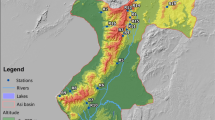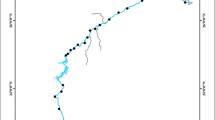Abstract
The rivers and streams of the Pampean plain are subjected to the impact of agriculture, cattle-raising and industrial activities. The largest urban center of Argentina is located here. The most important stresses on rivers and streams in the Pampean plain are organic enrichments (discharge of insufficiently treated sewage), nutrients, heavy metals, pathogenic agents, pesticides, herbicides and physical changes produced by dredging and canalisation. The epipelic community is suitable for biomonitoring purposes because it allows for comparing similar substrates along the rivers and streams. A total of 164 samples of epipelic diatoms were collected during 1995-1999 from Pampean rivers and streams. The analysis of these samples resulted in the development of a specific biotic index: the Pampean Diatom Index (IDP). The results were correlated with the main chemical water characteristics and with other biotic indices. This study suggests that the IDP is integrating organic pollution and eutrophication and can be applied for monitoring the biological quality of rivers and streams in the Pampean plain.
Similar content being viewed by others
References
American Public Health Association (APHA) (1995) Standard methods for the examination of water and wastewater. American Public Health Association, American Water Works Association and Water Pollution Control Federation. 19th edition, Washington, D.C.
Cazaubon A (1991) Problems and objectives of sampling river algae for monitoring. In: Whitton BA and Rott E (eds.), Use of Algae for Monitoring Rivers. Proc. International Symposium 26–28 May 1991, Germany, pp. 17–20
Cazaubon A (1996) Algal epiphytes, a methodological problem in river monitoring In: Whitton BA, Rott E and Friedrich G (eds.), Use of Algae forMonitoring Rivers II. International Symposium, Innsbruck Austria, 17–19 September 1995, pp. 47–50
Dell'Uomo A (1991) Use of benthic macroalgae for monitoring rivers in Italy. In: Whitton BA and Rott E (eds.), Use of Algae for Monitoring Rivers. Proceedings of International Symposium 26–28 May 1991, Germany, pp. 129–138
Dell'Uomo A (1995) Assessment of water quality of an Apennine river as a pilot study for diatom-based monitoring of italian watercourses. In: Whitton BA and Rott E (eds.), Use of Algae for Monitoring Rivers. Proceedings of International Symposium 17–19 September 1995, Austria, pp. 65–72
Descy J-P and Coste M (1990) Utilisation des diatomeés benthiques pour l'evaluation de la qualité des eaux courants. Rapport Final, EC contract B–71–23, 64 pp
Descy J-P and Ector L (1999) Use of diatoms for monitoring rivers in Belgium and Luxemburg. Prygiel J, Whitton BA and Bukowska J (eds.), Use of Algae for Monitoring Rivers III. Proceedings of International Symposium 29 September-1 October 1997, 1991, Germany, pp. 128–137
Frenguelli J (1941) Diatomeas del Río de la Plata. Rev Mus de La Plata Bot. 2: 213–334
Gómez N (1998). Use of epipelic diatoms for evaluation of water quality in the Matanza-Riachuelo (Argentina), a pampean plain river. Water Res 32: 2029–2034
Gómez N (1999). Epipelic diatom from Matanza-Riachuelo river (Argentina), a highly polluted basin from the pampean plain: biotic indices and multivariate analysis. Aquat Ecosyst Health Manage 2: 301–309
Hustedt F (1930) Bacillariophyta (Diatomeae) In: Pascher A (ed.), Die Susswasserflora Mitteleuropas, Vol. 10. Jena, 465 pp
Johnson DL (1998) In: Thomson (ed.), Métodos multivariados aplicados al análisis de datos. México, 508 pp
Kaan E (1978) Untersuchungen zur Ökophysiologie einiger Süßwasserrotalgen. Decheniana 136: 31–42
Kelly MG (1996) Discussion on diatom-based methods. In:Whitton BA and Rott E (eds.), Use of Algae for Monitoring Rivers II, Austria, 196 pp
Kolkwitz, R and Marson (1908) Ökologie der pflanzlichen Saprobien. Ver Deutsche Bot Ges 26: 505–519
Krammer K and Lange-Bertalot H (1986) Bacillariophyceae, Naviculaceae. Die Susswasserflora von Mitteleuropa 2/1 Stuttgart, 876 pp
Krammer K and Lange-Bertalot H (1991) Bacillariophyceae, Centrales, Fragilariaceae, Eunotiaceae. Die Susswasserflora von Mitteleuropa. 2/3 Stuttgart, 576 pp
Krammer K and Lange-Bertalot H (1987) Bacillariophyceae, Bacillariaceae, Epithemiaceae, Surirellaceae. Bibliotheca Diatomologica, 2/2 Stuttgart, 289 pp
Lobo EA and Bender EP (1998). Aplicabilidade de sistemas de sapróbios para avaliacao da qualidade de águas correntes fortemente poluídas, no sul do Brasil, utilizando diatomaceas. Anais do IV Congresso Latino Americano de Ficología, 1996. Minas Gerais Brasil 1: 401–422
Lobo EA, Callegaro VL, Oliveira MA, Salomoni SE, Schuler S and Asai K (1996) Pollution tolerant diatoms from lotic systems in the Jacuí basin, Río Grande do Sul, Brazil. Iheringia, Ser Bot 47: 45–72
Lowe R and Laliberte GD (1996) Benthic stream algae: distribution and structure. In: Hauer, R & Lamberti GA (eds.), Stream Ecology, Academic Press, California, 669 pp
Mackereth FJ, Heron FJH and Talling JF (1978) Water analisis: some revised methods for limnologist. Freshwater Biological Association, Scientific Publication No. 36, 120 pp
Patrick R and Reimer CW (1966) The Diatoms of the United States, exclusive of Alaska and Hawaii. Academy of Natural Sciences of Philadelphia, Vol. I., 668 pp
Patrick R and Reimer CW (1975) The Diatoms of the United States, exclusive of Alaska and Hawaii. Academy of Natural Sciences of Philadelphia Vol. II., 213 pp
Prygiel J, Whitton BA and Bukowska J (eds.) (1999) Use of Algae for Monitoring Rivers III. Proc. III International Symposium. Douai, France 29 September-1 October 1997, 271 pp
Rodrigues Capítulo A, Tangorra M and Ocón C (2001) Use of benthic macroinvertebrates to assess the biological status of Pampean streams in Argentina. Aquat Ecol 35: 109–119
Sala JM, Gonzáles N and Kruse EE (1983) Generalización hidrológica de la provincia de Buenos Aires. In: Prego J (ed.), Coloquio Internacional sobre hidrología de grandes llanuras. 11–20 abril, 1983. Olavarría, Argentina 975–1009
Stevenson RJ (1984) Epilithic and epipelic diatoms in the Sandusky River, with emphasis on species diversity and water pollution. Hydrobiologia 114: 114–161
Tangorra M, Mercado, L, Rodrígues Capítulo A and Gómez N (1998) Evaluación de la calidad ecológica del A El Gato a partir del estudio del bentos, fitoplancton y variables físico-químicas. Anal Congr Nac Agua 5: 212–220
Whitton BA and Rott E (eds.) (1996) Use of Algae for Monitoring Rivers II. Proc. II International Symposium, 17–19 September 1995, Innsbruck, Austria, 196 pp
Whitton BA, Rott E and Friedrich G (eds.) (1991) Use of Algae for Monitoring Rivers. Proc. International Symposium 26–28 May 1991, Germany, 183 pp
Author information
Authors and Affiliations
Rights and permissions
About this article
Cite this article
Gómez, N., Licursi, M. The Pampean Diatom Index (IDP) for assessment of rivers and streams in Argentina. Aquatic Ecology 35, 173–181 (2001). https://doi.org/10.1023/A:1011415209445
Issue Date:
DOI: https://doi.org/10.1023/A:1011415209445




